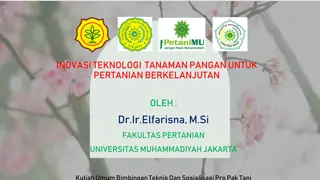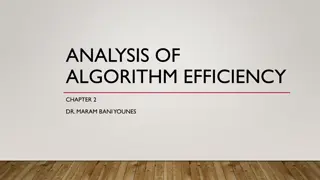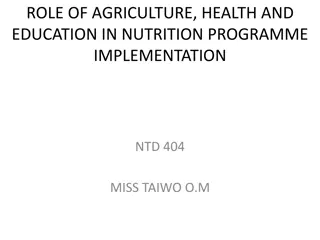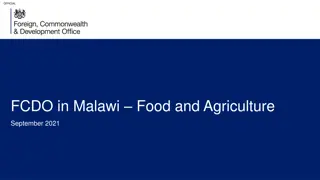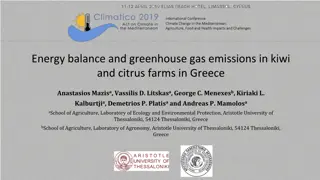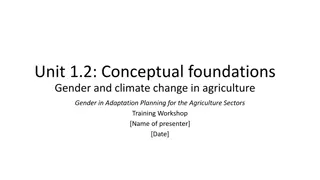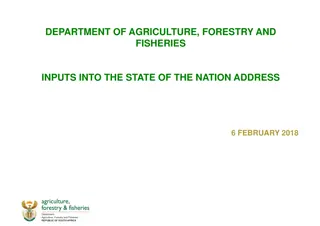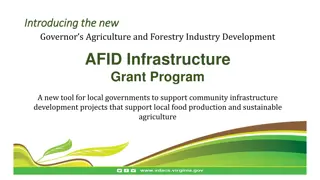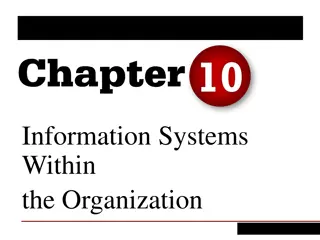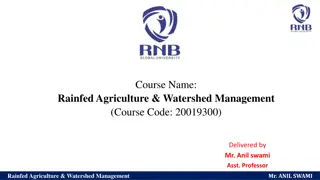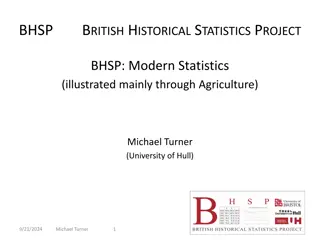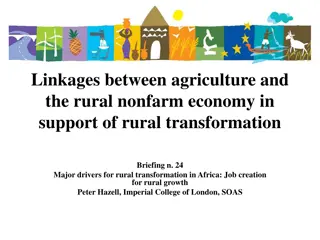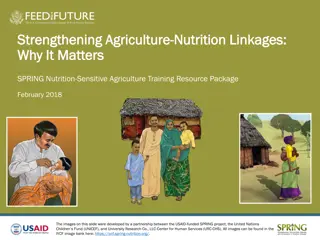Resource Use Efficiency in Agriculture Systems
This study explores the Multiple Resource Use Efficiency (mRUE) in agriculture systems, discussing the impact of assumptions embedded in data analysis and the importance of considering unknown processes within ecosystems. The researchers present findings on relationships between variables and propose dynamic factor analysis as a method to retain time-series information in data analysis.
Download Presentation

Please find below an Image/Link to download the presentation.
The content on the website is provided AS IS for your information and personal use only. It may not be sold, licensed, or shared on other websites without obtaining consent from the author.If you encounter any issues during the download, it is possible that the publisher has removed the file from their server.
You are allowed to download the files provided on this website for personal or commercial use, subject to the condition that they are used lawfully. All files are the property of their respective owners.
The content on the website is provided AS IS for your information and personal use only. It may not be sold, licensed, or shared on other websites without obtaining consent from the author.
E N D
Presentation Transcript
Multiple Resource Use Efficiency (mRUE) In Agriculture Systems David E. Reed, JiquanChen, Michael Abraha, G. Philip Robertson, Kyla Dahlin Michigan State University May 14, 2018 33rd Conference on Agricultural and Forest Meteorology 1
What Happens When We Have Fewer Assumptions Imbedded Within Our Data? David E. Reed, Jiquan Chen, Michael Abraha, G. Philip Robertson, Kyla Dahlin Michigan State University May 14, 2018 33rd Conference on Agricultural and Forest Meteorology 2
If Our Data Could Talk, We Assume We Know What It Will Say In some cases, okay, fine! Modeled PAR at a site might be okay May 14, 2018 33rd Conference on Agricultural and Forest Meteorology 3
If Our Data Could Talk, We Assume We Know What It Will Say But complex biological systems are noisy May 14, 2018 33rd Conference on Agricultural and Forest Meteorology 4
We Assume Relationships Between Variables Embedded in the language of drivers/predictors May 14, 2018 33rd Conference on Agricultural and Forest Meteorology 5
What Happens If We Dont Assume Any Of This? Using ecosystem observations, look for a unknown process embedded within the ecosystem May 14, 2018 33rd Conference on Agricultural and Forest Meteorology 6
Dynamic Factor Analysis Similar to Principal Company Analysis Retains time-series information in the data! Okay with gaps in that time-series Multiple ecosystem observations are driven by an unseen state (or multiple states) This state can be modeled and Loading Factors related to each observation can be solved for May 14, 2018 33rd Conference on Agricultural and Forest Meteorology 7
Multiple Resource Use Efficiency Example site- year (site T4) Time-series of mRUE overlaid with time- series of model results May 14, 2018 33rd Conference on Agricultural and Forest Meteorology 8
Multiple Resource Use Efficiency Time-series and loading from unseen state May 14, 2018 33rd Conference on Agricultural and Forest Meteorology 9
Multiple Resource Use Efficiency DFA Model does NOT predict NEP, shown only to illustrate May 14, 2018 33rd Conference on Agricultural and Forest Meteorology 10
Multiple Resource Use Efficiency Available energy dominates annual ecosystem processes Growing season is energy limited Mean WUE 0.22 Mean EUE 0.50 Mean CUE 0.22 May 14, 2018 33rd Conference on Agricultural and Forest Meteorology 11
Multiple Resource Use Efficiency Within the growing season water and energy are both important Ecosystems uptake as much carbon as possible, disregarding respiration requirements Mean WUE 0.65 Mean EUE 0.73 Mean CUE 0.07 May 14, 2018 33rd Conference on Agricultural and Forest Meteorology 12
Multiple Resource Use Efficiency Similar story by month in the summer August energy use becomes more important than water, while carbon use is significantly negative WUE 1.00->0.86->0.74 EUE 0.99->0.76->0.83 CUE 0.09->-0.02->-0.38 May 14, 2018 33rd Conference on Agricultural and Forest Meteorology 13
Multiple Resource Use Efficiency 2012, decrease in WUE and EUE in August Largest draught in >10 years May 14, 2018 33rd Conference on Agricultural and Forest Meteorology 14
Multiple Resource Use Efficiency 2015 The Midwest's 6th wettest June on record May 14, 2018 33rd Conference on Agricultural and Forest Meteorology 15
Multiple Resource Use Efficiency 2015 Precipitation continues slightly into July May 14, 2018 33rd Conference on Agricultural and Forest Meteorology 16
Multiple Resource Use Efficiency 2015 Back to average in August May 14, 2018 33rd Conference on Agricultural and Forest Meteorology 17
Multiple Resource Use Efficiency Energy Use Efficiency has largest loading factor at annual timescales At smaller timescales, Water and Energy Use dominate While Carbon Use is a smaller factor May 14, 2018 33rd Conference on Agricultural and Forest Meteorology 18
Multiple Resource Use Efficiency Take Home Points Novel combined RUE method to quantify and examine un-observed ecosystem processes based on observed time-series Applicable for multiple ecological applications Tailor made powerful statistical method for EC datasets May 14, 2018 33rd Conference on Agricultural and Forest Meteorology 19
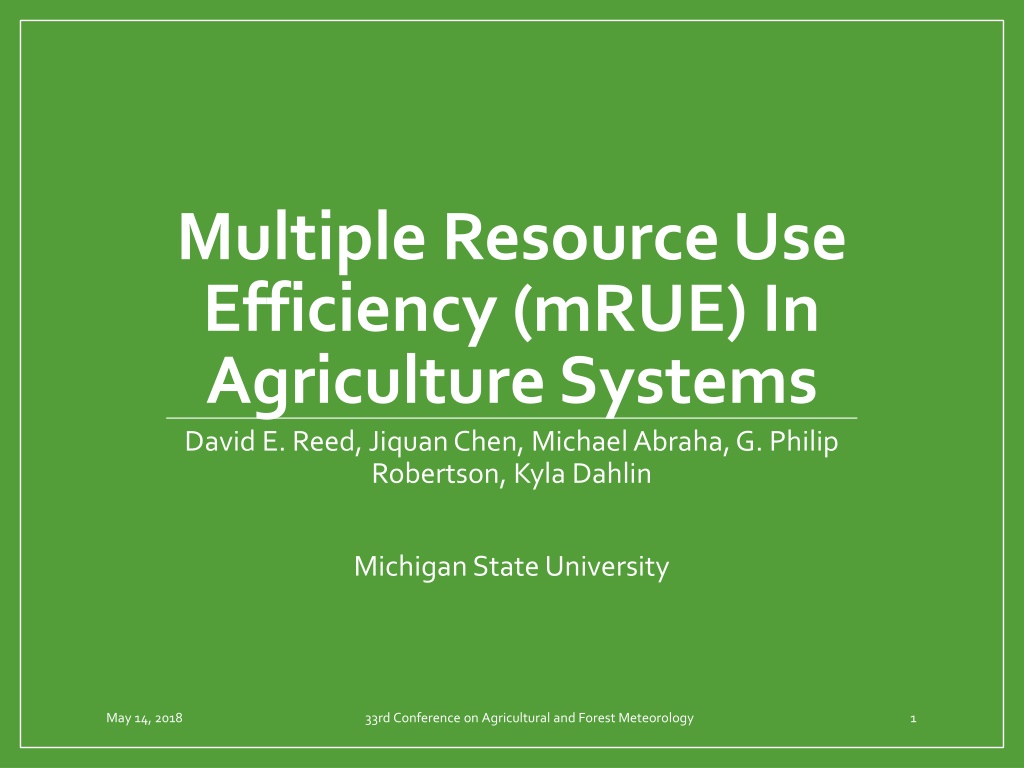
 undefined
undefined




